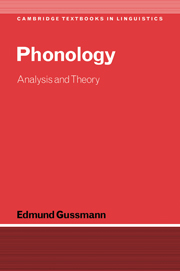Book contents
- Frontmatter
- Contents
- Preface
- List of abbreviations
- 1 Sounds and segments
- 2 The melody and the skeleton
- 3 Domains and phonological regularities
- 4 The syllable
- 5 More on codas
- 6 Some segmental regularities
- 7 Syllable structure and phonological effects: quantity in Icelandic
- 8 Segmental double agents
- 9 Words and feet: stress in Munster Irish
- Conclusion
- Appendix The phonetic alphabet of the International Phonetic Association
- References
- Index
5 - More on codas
Published online by Cambridge University Press: 05 June 2012
- Frontmatter
- Contents
- Preface
- List of abbreviations
- 1 Sounds and segments
- 2 The melody and the skeleton
- 3 Domains and phonological regularities
- 4 The syllable
- 5 More on codas
- 6 Some segmental regularities
- 7 Syllable structure and phonological effects: quantity in Icelandic
- 8 Segmental double agents
- 9 Words and feet: stress in Munster Irish
- Conclusion
- Appendix The phonetic alphabet of the International Phonetic Association
- References
- Index
Summary
Introduction
In the previous chapter we concentrated on some basic properties of the syllabic organisation of language, that is on a level of organisation above and beyond the skeletal and melodic structure. This additional level of representation is necessary in order to formulate observations and generalisations which it would be very difficult or impossible to state otherwise. One point has been stressed repeatedly: syllabic organisation is not restricted to a mere division of segmental strings into chunks called onsets, rhymes, nuclei and codas. We have seen cases where syllabic units do not correspond to any segmental material, such as empty onsets or empty nuclei, which shows that syllabic organisation, while connected with the skeletal and melodic levels, comprises a fundamentally self-contained structure. The traditional notion of syllabification, i.e. the exhaustive division or compartmentalisation of a word into segments needs to be revised. In the past this was a relatively simple mechanical procedure whereby each segment was assigned to some syllabic unit with nothing left unsyllabified. While the need to incorporate melodic units into syllabic constituents is not controversial, we maintain that there may be syllabic units which are not directly manifested through segmental material. In other words, syllabification is an operation which involves the phonological structure of the language rather than just sequences of segments of phonetically transcribed words.
In what follows we shall continue to explore the syllabic structure of words. We will concentrate on cases where the phonological facts require that syllabification should depart from melodic sequences which are directly accessible for inspection.
- Type
- Chapter
- Information
- PhonologyAnalysis and Theory, pp. 91 - 117Publisher: Cambridge University PressPrint publication year: 2002



